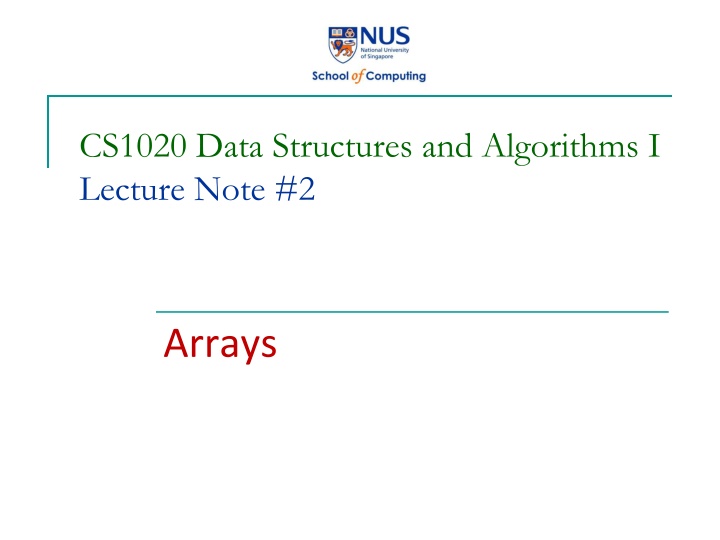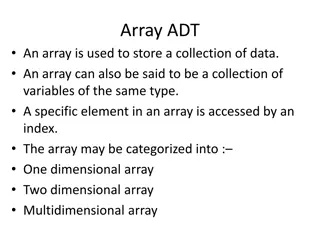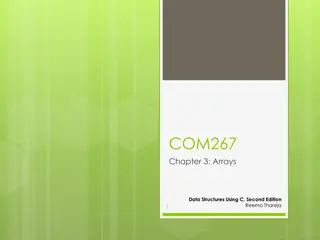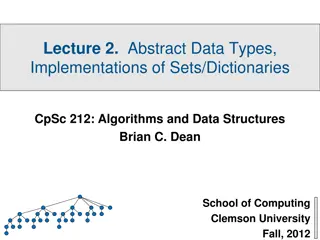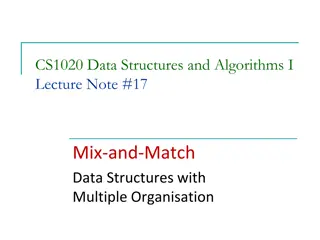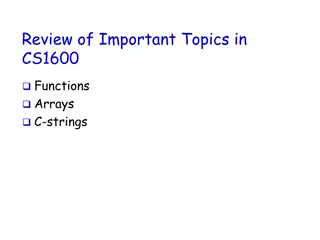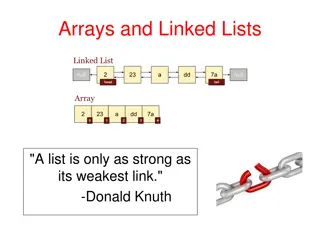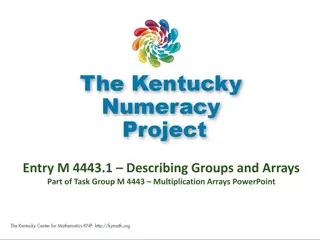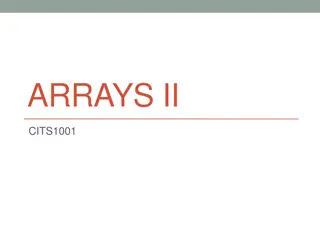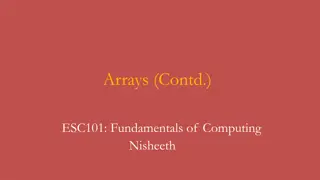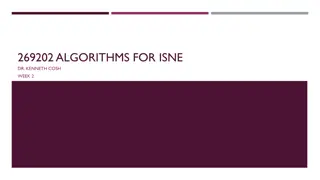CS1020 Data Structures and Algorithms: Arrays Lecture Overview
Fundamentals of arrays in programming through this detailed lecture note. Learn how arrays are used to organize data in languages like C and Java, pass arrays as parameters, and handle common mistakes. Delve into the world of multidimensional arrays and understand the drawbacks associated with array usage. Gain insights into storing homogeneous data efficiently using arrays and dive into coding examples in C for scanning, printing, and summing array elements.
Download Presentation

Please find below an Image/Link to download the presentation.
The content on the website is provided AS IS for your information and personal use only. It may not be sold, licensed, or shared on other websites without obtaining consent from the author.If you encounter any issues during the download, it is possible that the publisher has removed the file from their server.
You are allowed to download the files provided on this website for personal or commercial use, subject to the condition that they are used lawfully. All files are the property of their respective owners.
The content on the website is provided AS IS for your information and personal use only. It may not be sold, licensed, or shared on other websites without obtaining consent from the author.
E N D
Presentation Transcript
CS1020 Data Structures and Algorithms I Lecture Note #2 Arrays
Objectives Using arrays to organise data. [CS1020 Lecture 2: Arrays] 2
References Book Array: Chapter 1, Section 1.1, pages 35 to 38 http://www.comp.nus.edu.sg/ ~cs1020/2_resources/lectures.html CS1020 website Resources Lectures http://www.comp.nus.edu.sg/ ~cs1020/2_resources/lectures.html http://www.comp.nus.edu.sg/ ~cs1020/2_resources/lectures.html http://www.comp.nus.edu.sg/ ~cs1020/2_resources/lectures.html [CS1020 Lecture 2: Arrays] 3
Outline 1. Array 1.1 Introduction 1.2 Array in C 1.3 Array in Java 1.4 Array as a Parameter 1.5 Detour: String[] in main() method 1.6 Returning an Array 1.7 Common Mistakes 1.8 2D Array 1.9 Drawback [CS1020 Lecture 2: Arrays] 4
1 Array A collection of homogeneous data
1. Array Introduction Array is the simplest way to store a collection of data of the same type (homogeneous) It stores its elements in contiguous memory Array index begins from zero Example of a 5-element integer array A with elements filled A 24 7 -3 15 9 A[0] A[1] A[2] A[3] A[4] [CS1020 Lecture 2: Arrays] 6
1. Array Array in C (1/2) #include <stdio.h> #define MAX 6 // To read values into arr and return // the number of elements read. int scanArray(double arr[], int max_size) { int size, i; int scanArray(double [], int); void printArray(double [], int); double sumArray(double [], int); printf("How many elements? "); scanf("%d", &size); if (size > max_size) { printf("Exceeded max; you may only enter"); printf(" %d values.\n", max_size); size = max_size; } printf("Enter %d values: ", size); for (i=0; i<size; i++) { scanf("%lf", &arr[i]); } return size; } int main(void) { double list[MAX]; int size; size = scanArray(list, MAX); printArray(list, size); printf("Sum = %f\n", sumArray(list, size)); return 0; } sum_array.c [CS1020 Lecture 2: Arrays] 7
1. Array Array in C (2/2) sum_array.c // To print values of arr void printArray(double arr[], int size) { int i; for (i=0; i<size; i++) printf("%f ", arr[i]); printf("\n"); } // To compute sum of all elements in arr double sumArray(double arr[], int size) { int i; double sum = 0.0; for (i=0; i<size; i++) sum += arr[i]; return sum; } [CS1020 Lecture 2: Arrays] 8
1. Array Array in Java (1/2) In Java, array is an object. Every array has a public length attribute (it is not a method!) TestArray1.java public class TestArray1 { public static void main(String[] args) { int[] arr; // arr is a reference Declaring an array: datatype[] array_name arr = new int[3]; // create a new integer array with 3 elements // arr now refers (points) to this new array Constructing an array: array_name = new datatype[size] System.out.println("Length = " + arr.length); arr[0] = 100; arr[1] = arr[0] - 37; arr[2] = arr[1] / 2; for (int i=0; i<arr.length; i++) System.out.println("arr[" + i + "] = " + arr[i]); } } // using the length attribute Length = ? arr[0] = ? arr[1] = ? arr[2] = ? Accessing individual array elements. [CS1020 Lecture 2: Arrays] 9
1. Array Array in Java (2/2) Alternative loop syntax for accessing array elements Illustrate toString() method in Arrays class to print an array TestArray2.java public class TestArray2 { public static void main(String[] args) { // Construct and initialise array double[] arr = { 35.1, 21, 57.7, 18.3 }; System.out.println("Length = " + arr.length); // using the length attribute Length = 4 35.1 21.0 57.7 18.3 35.1 21.0 57.7 18.3 [35.1, 21.0, 57.7, 18.3] for (int i=0; i<arr.length; i++) { System.out.print(arr[i] + " "); } System.out.println(); Syntax (enhanced for-loop): for (datatype e: array_name) for (double element: arr) { System.out.print(element + " "); } System.out.println(); System.out.println(Arrays.toString(arr)); } } // Alternative way Go through all elements in the array. e automatically refers to the array element sequentially in each iteration Using toString() method in Arrays class [CS1020 Lecture 2: Arrays] 10
1. Array Array as a Parameter The reference to the array is passed into a method Any modification of the elements in the method will affect the actual array TestArray3.java public class TestArray3 { public static void main(String[] args) { int[] list = { 22, 55, 33 }; swap(list, 0, 2); for (int element: list) System.out.print(element + " "); System.out.println(); } // To swap arr[i] with arr[j] public static void swap(int[] arr, int i, int j) { int temp = arr[i]; arr[i] = arr[j]; arr[j] = temp; } } [CS1020 Lecture 2: Arrays] 11
1. Array Detour: String[] in main() method The main() method contains a parameter which is an array of String objects We can use this for command-line arguments TestCommandLineArgs.java public class TestCommandLineArgs { public static void main(String[] args) { for (int i=0; i<args.length; i++) System.out.println("args[" + i + "] = " + args[i]); } } java TestCommandLineArgs The "Harry Potter" series has 7 books. args[0] = The args[1] = Harry Potter args[2] = series args[3] = has args[4] = 7 args[5] = books. [CS1020 Lecture 2: Arrays] 12
1. Array Returning an Array Array can be returned from a method TestArray4.java public class TestArray4 { public static void main(String[] args) { double[] values; 999.0 499.5 333.0 249.75 199.8 values = makeArray(5, 999.0); for (double value: values) { System.out.println(value + " "); } } Return type: datatype[] // To create an array and return it to caller public static double[] makeArray(int size, double limit) { double[] arr = new double[size]; for (int i=0; i < arr.length; i++) arr[i] = limit/(i+1); return arr; } } [CS1020 Lecture 2: Arrays] 13
1. Array Common Mistakes (1/3) length versus length() To obtain length of a String object str, we use the length() method Example: str.length() To obtain length (size) of an array arr, we use the length attribute Example: arr.length Array index out of range Beware of ArrayIndexOutOfBoundsException public static void main(String[] args) { int[] numbers = new int[10]; . . . for (int i = 1; i <= numbers.length; i++) System.out.println(numbers[i]); } [CS1020 Lecture 2: Arrays] 14
1. Array Common Mistakes (2/3) When you have an array of objects, it s very common to forget to instantiate the array s objects. Programmers often instantiate the array itself and then think they re done that leads to java.lang.NullPointerException Example on next slide It uses the Point class in the API Refer to the API documentation for details [CS1020 Lecture 2: Arrays] 15
1. Array Common Mistakes (3/3) array Point[] array = new Point[3]; for (int i=0; i<array.length; i++) { array[i].setLocation(1,2); } null null null There are no objects referred to by array[0], array[1], and array[2], so how to call setLocation() on them?! x 0 1 Corrected code: y array 0 2 Point[] array = new Point[3]; for (int i=0; i<array.length; i++) { array[i] = new Point(); array[i].setLocation(1,2); } x 0 1 y 0 2 x 0 1 y 0 2 [CS1020 Lecture 2: Arrays] 16
1. Array 2D Array (1/2) A two-dimensional (2D) array is an array of array. This allows for rows of different lengths. // an array of 12 arrays of int int[][] products = new int[12][]; int[][] array2D = { {4,5,2}, {1,3}, {7,1,5,6} }; 4 array2D 5 2 1 3 7 1 5 6 [CS1020 Lecture 2: Arrays] 17
1. Array public class Test2DArray { public static void main(String[] args) { int[][] array2D = { {4, 5, 2}, {1, 3}, {7, 1, 5, 6} }; 2D Array (2/2) array2D 4 5 2 1 3 7 1 5 6 System.out.println("array2D.length = " + array2D.length); for (int i = 0; i < array2D.length; i++) System.out.println("array2D[" + i + "].length = " + array2D[i].length); for (int row = 0; row < array2D.length; row++) { for (int col = 0; col < array2D[row].length; col++) System.out.print(array2D[row][col] + " "); System.out.println(); } } } Test2DArray.java array2D.length = 3 array2D[0].length = ? array2D[1].length = ? array2D[2].length = ? ? ? ? [CS1020 Lecture 2: Arrays] 18
1. Array Drawback Array has one major drawback: Once initialized, the array size is fixed Reconstruction is required if the array size changes To overcome such limitation, we can use some classes related to array Java has an Array class Check API documentation and explore it yourself However, we will not be using this Array class much; we will be using some other classes such as Vector or ArrayList (to be covered later) Before doing Vector/ArrayList, we will introduce another concept later called Generics [CS1020 Lecture 2: Arrays] 19
Practice Exercises These practice exercises are mounted on CodeCrunch this week #04: Basic Statistics Computing mean and standard deviation #05: Missing Digits Using array of primitive type #06: Row and Column Sums Two-dimensional array The files are also available on the CS1020 website: http://www.comp.nus.edu.sg/~cs1020/4_misc/practice.html You are urged to work on these exercise as they are important for you to cement your basic understanding of the topics that are covered so far [CS1020 Lecture 2: Arrays] 20
Missing Digits (1/2) Pract. Ex. #05 [This is adapted from a CS1010 exercise in C] Write a program MissingDigits.java to read in a positive integer and list out all the digits that do not appear in the input number. (Assume input value has no leading zeroes.) You are to use primitive array, not Vector, ArrayList or any other related classes. You should use a boolean array. Sample run: Enter a number: 73015 Missing digits in 73015: 2 4 6 8 9 [CS1020 Lecture 2: Arrays] 21
Missing Digits (2/2) Pract. Ex. #05 What is the boolean array for? Idea? [CS1020 Lecture 2: Arrays] 22
